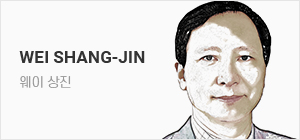이 기사는 해외 석학 기고글 플랫폼 '헤럴드 인사이트 컬렉션'에 게재된 기사입니다.
| ||
| Ships carry out container loading and unloading operations at the Dapukou container Terminal at Zhoushan Port, Zhejiang province, China, April 9, 2024. [Getty Images] |

After seven decades of trade liberalization, trade agreements, and trade expansion, momentum for further liberalization had been exhausted by 2016. Growing dissatisfaction over the unequal spread of the benefits and costs of trade fueled the Brexit vote in June 2016, the opposition of both US presidential candidates to the Transpacific Partnership agreement, and the election victory of “tariff-man” Donald Trump.
Arguments over trade policy have long been a feature of US and other advanced country politics. But Covid and China changed the balance. Growing protectionist sentiment, a public health crisis, and the perceived China threat proved insurmountable for liberal trade advocates. Although the incoming Biden administration reversed many of Trump‘s policies, it continued and extended its trade restrictive measures.
The shift in the view of trade from a strength to a weakness illustrates this point. US national security officials had long worried that trade led to dependency on foreign countries and potential vulnerability. What was once a peripheral argument became the starting point of policy discussions, where trade and economic policy are now cast in national security and economic security terms.
“Economic dependencies built up over decades of liberalization had become really perilous...the kind of dependencies that could be exploited for economic or geopolitical leverage” ― National Security Advisor Jake Sullivan, Brookings Institution, April 27, 2023

But this argument is flawed. Concentrating your purchases on one supplier is only a vulnerability if there are no alternatives or substitutes.
And with time, and at some cost, there are always substitutes. Look at three almost perfect test cases of the argument that trade dependence creates significant vulnerability. These are China‘s cut in its rare earth exports and a ban on their sale to Japan in 2010, Russia’s cutoff of gas supplies to Western Europe after invading Ukraine, and the West‘s economic and financial sanctions against Russia.
Opportunities for substitution appeared minimal in each case. China accounted for more than 97 percent of global rare earth production in 2010(1), European energy distribution was organized around pipeline deliveries from Russia, and the sanctions on Russia were the most widespread and severe ever imposed.
What is striking now is how little effect these actions actually had. Japan (and the rest of the world) recycled rare earths, reduced their use in products, and developed new sources. Europe cut industrial demand for gas and quickly turned to LNG imports. And Russia has found ways to evade both trade and financial sanctions. Time and again, we greatly underestimate the ingenuity and ability of private firms and countries to adjust and adapt to events, embargoes and sanctions.
Covid extended trade dependency concerns beyond embargos and sanctions to worries about shortages and supply security. Shortages of medical equipment, semiconductors, and many other goods during Covid were labelled “supply disruptions” or supply chain breakdowns. This characterization was highly misleading. Although supplies from Chinese factories were interrupted early in 2020 and again in 2022, supply interruptions were only a minor problem. Industry production and supply chains largely operated at full capacity during Covid.
The real cause of the shortages during Covid was unprecedented spikes in demand that strained, and in many cases exceeded supply capacity, even with producers running at full volume. Demand for medical ventilators, test kits, and personal protective equipment jumped to multiples of previous levels. Demand for toilet paper, home office equipment, and other stay-at-home goods also ballooned.
The shift towards goods was so strong that it was visible at the macroeconomic level. US households‘ purchases of goods normally grow by about 3 to 4 percent per year. But in April 2021, US consumer demand for goods was 18% higher than it was at the previous peak in December 2019.
As the Covid pandemic moved across countries, trade, and the ability to draw on global supply networks, was a source of resilient supply. In the United States, imports of sterilizers and syringe parts tripled from what they were in 2019, and imports of clinical thermometers rose by a factor of 14(2). Gilead, the maker of the anti-viral remdesivir, assembled a network of over 40 companies in North America, Europe, and Asia to boost supply from available supplies of 5000 doses in January 2020 to 2 million doses by the end of the year(3). Shortages were smaller than they would have been because of imports. The lesson is clear: in the face of spikes in demand, imports increase security(4).
| ||
| President Joe Biden visits a Wolfspeed semiconductor manufacturing facility in Durham, North-Carolina to kick pff the Investing in America Tour in Durham NC, United States on March 28, 2023 [Getty Images] |
But the political appeal of the supply argument was strong. Candidate Biden campaigned on “Build in America”. When he took office in 2021, policy discussion centered around supply ― supply security, supply chain resilience, and bringing back manufacturing.
In the face of complaints from partners, Administration officials have recently been at pains to say that US policy means “friend-shoring” and not “reshoring” of US supplies.
Unfortunately, the US shift towards subsidy-based industrial policy ― both as a mirroring of Chinese policy and as a way to address climate change ― makes a “we are all friends” neutrality very difficult to achieve. Legislators are understandably reluctant to have taxpayers support foreign production and employment, and each of the Biden Administration‘s major initiatives ― the infrastructure bill, the Inflation Reduction Act, and the Chips Act ― have clear incentives for domestic production.
Semiconductors exemplify the hazards of thinking that domestic production means security. The burst in IT equipment demand coupled with a turnaround in overall goods purchases led to a huge spike in demand for semiconductors in 2021. Industry sales rose by 26 percent during the year. Even so, many potential buyers were disappointed, as the industry hit full capacity(5). Automakers who had canceled chip orders in the depths of Covid found themselves at the end of the queue when auto demand revived, limiting their output of cars.
The connection between semiconductors and advanced technology industries and military hardware, huge Chinese subsidies to develop its own domestic industry, and the real possibility that the production of the most advanced semiconductors could be halted by a conflict over Taiwan has produced a race to promote domestic semiconductor production, including the most advanced chips, among the United States and its partners.
Even for the United States, the efforts to develop one‘s own semiconductor industry will be tremendously costly, probably unsuccessful, and will reduce national security rather than enhance it.
The reason the semiconductor industry is globalized, with a supply chain that crosses the world several times, is that it‘s built on specialization, the cost savings from large-scale production, and the technological advantages developed by individual firms. Many examples stand out: in the United States for EDA software, Korea for advanced memory, Japan for photoresist chemicals, Taiwan for chip fabrication, and the Netherlands for chip-making equipment.
Policy discussions focus on fabrication, but the industry depends on, and requires, far more than that. A truly indigenized industry requires not just fabrication, but also design, manufacturing equipment, and a range of other inputs and products. Chinese efforts to achieve self-sufficiency face the daunting challenge of re-creating the myriad firms in the global supply chain and the tremendous advantage they give the United States and its partners.
This is why trying to achieve domestic semiconductor production makes no sense from a national security standpoint. Why should the West try to replicate through policy the strategic disadvantage that China has from its isolation?
___________________________


70년간의 무역 자유화와 무역 협정 및 무역 확대 이후, 2016년엔 추가적인 자유화를 위한 모멘텀이 고갈됐다. 무역의 혜택과 비용이 불평등하게 배분되는 것에 대한 불만이 커지면서 2016년 6월 브렉시트(Brexit) 투표가 촉발됐고, 미국의 양측 대통령 후보 모두 환태평양경제동반자 협정(TPP)에 반대했으며, ‘관세맨’ 도널드 트럼프가 선거에서 승리했다.
무역 정책에 대한 논쟁은 오랫동안 미국 및 다른 선진국 정치의 특징이었다. 그러나 코로나19와 중국이 그 균형을 흔들었다. 자유 무역 옹호자들은 커져가는 보호주의 정서, 공중 보건 위기 및 중국의 위협을 이길 수 없었다. 그 후 바이든 행정부는 트럼프가 추진했던 많은 정책을 뒤집었지만, 무역 제한 조치들은 유지·확대했다.
무역을 바라보는 시선이 강점에서 약점으로 바뀌었다는 사실은 이 점을 잘 보여준다. 미국 국가안보 관리들은 오랫동안 무역이 외국에 대한 의존성과 잠재적인 취약성을 초래할 수 있다고 우려해 왔다. 그러나 한때는 지엽적이었던 이 논쟁이 정책 논의의 출발점이 됐고, 이제 무역과 경제 정책은 국가 안보와 경제 안보의 관점에서 수립되고 있다.
“수십 년의 자유화 기간 동안 구축된 경제적 의존성은 아주 위험한 상태다. 이러한 의존성은 경제적 또는 지정학적 영향력을 미치기 위해 악용될 수 있다.”(제이크 설리반 미국 국가안보보좌관 브루킹스연구소 강연·2023년 4월 27일)

그러나 이 주장에는 결함이 있다. 하나의 업체에 구매를 집중하는 것은 대안이나 대체품이 없는 경우에만 취약점이 될 수 있다.
시간이 흐르고 약간의 비용을 들이면 항상 대체품은 있다. 무역에 의존하면 상당한 취약점을 갖게 된다는 주장을 거의 완벽하게 시험해 본 세 가지 사례를 살펴보자. 바로 2010년 중국의 희토류 수출 삭감 및 일본 판매 제한, 우크라이나 침공 이후 러시아의 서유럽 가스 공급 중단, 그리고 러시아에 대한 서방의 경제·금융 제재 사례다.
이 세 경우 모두 대체 가능성이 아주 적을 것이라고 여겨졌다. 2010년 중국은 전 세계 희토류 생산량의 97% 이상을 차지했고, 유럽의 에너지 배분은 러시아로부터 파이프라인을 통해 공급되는 물량을 중심으로 조직돼 있었으며, 러시아에 대한 서방의 제재는 역대 최고로 광범위하고 가혹했다.
현재 이러한 조치가 실제로 미친 영향이 얼마나 미미했는가를 보면 놀라울 따름이다. 일본 (및 다른 나라들)은 희토류를 재활용하고, 제품에 사용되는 양을 줄였으며, 새로운 자원을 개발했다. 유럽은 산업의 가스 수요를 줄이고 신속하게 LNG 수입으로 전환했다. 그리고 러시아는 무역 제재와 금융 제재를 모두 회피할 수 있는 방법을 찾아냈다. 우리는 계속해서 민간 기업과 국가가 어떤 사건이나, 수출 금지 및 제재에 얼마나 독창적으로 잘 적응할 수 있는지 그 능력을 크게 과소평가하는 경향이 있다.
코로나19는 무역 의존도에 대한 우려를 수출 금지와 제재를 넘어 공급 부족과 공급 안보로까지 확대시켰다. 코로나19 동안 의료 장비, 반도체 및 기타 여러 재화의 부족은 ‘공급 붕괴’ 또는 공급망 와해라고 불렸다. 이러한 묘사는 큰 오해의 소지가 있다. 비록 2020년 초와 2022년에 중국으로부터의 공급이 중단됐지만 공급 중단은 사소한 문제에 불과했고, 산업 생산과 공급망은 코로나19 기간 동안 대부분 최대로 가동됐다.
코로나19 사태 동안 공급이 부족했던 진짜 원인은 전례 없는 수요 급증으로 공장들이 최대로 가동되는 와중에도 수요가 공급 능력을 초과하는 경우가 많았기 때문이다. 의료용 인공호흡기, 검사 키트, 개인 보호 장비에 대한 수요는 이전의 몇 배로 뛰어올랐다. 화장지, 재택근무 장비, 기타 집에서 필요한 재화에 대한 수요도 급증했다.
이러한 수요 변화는 너무 강력해 거시경제 수준에서도 눈에 띄게 나타났다. 미국 가구의 재화 구매는 일반적으로 매년 약 3~4%씩 증가한다. 그러나 2021년 4월 재화에 대한 미국 소비자의 수요는 이전 최고치인 2019년 12월보다 18% 더 높았다.
코로나19 팬데믹이 여러 국가로 확산됨에 따라 무역 및 글로벌 공급망을 활용할 수 있는 능력은 탄력적인 공급의 원천이었다. 미국에서는 살균기와 주사기 부품 수입이 2019년 대비 3배, 체온계 수입은 14배 늘었다. 항바이러스제 렘데시비르를 만드는 제약사인 길리어드는 2020년 1월 기준 5000회 분량이었던 공급량을 2020년 말까지 200만회 분량으로 늘리기 위해 북미·유럽 및 아시아에서 40개 넘는 기업으로 이뤄진 네트워크를 구축했다. 수입 덕분에 공급 부족이 완화된 것이다. 교훈은 분명하다. 수요가 급증할 땐 수입이 안보를 강화한다.

그러나 공급 쪽 주장의 정치적 매력은 강력했다. 바이든 후보는 ‘빌드 인 아메리카(Build in America)’를 주제로 캠페인을 벌였다. 2021년 바이든이 대통령으로 취임했을 때, 정책 논의는 공급, 즉 공급 안보와 공급망 탄력성 및 제조업을 다시 미국으로 가져오는 것을 중심으로 이뤄졌다.
우방국들의 불만에 직면한 미 행정부 관리들은 최근 미국의 정책은 제조업의 ‘리쇼어링(Reshoring·본국 이전)’이 아니라 ‘프렌드쇼어링(Friend-shoring·우방국 이전)’을 의미한다고 애써 해명했다.
불행히도 미국이 중국의 정책을 따라하고 또 기후 변화에 대처하는 방법으로 보조금 기반 산업 정책으로 전환하면서 ‘우리는 모두 친구’라는 중립성을 지키기가 매우 어려워졌다. 당연히 입법자들은 납세자들의 세금으로 해외 생산 및 고용을 지원하는 것을 꺼리고, 바이든 행정부의 주요 이니셔티브인 인프라 법안, 인플레이션 감소법, 반도체법은 국내 생산에 대한 명확한 인센티브를 담고 있다.
반도체는 국내 생산이 곧 안보라는 생각의 위험성을 잘 보여주는 예시다. IT 장비 수요 급증과 전반적인 재화 구매 회복으로 인해 2021년 반도체 수요가 크게 증가했다. 그 한 해 동안 반도체 업계의 매출은 26% 증가했다. 그럼에도 업계가 최대 생산 한도에 도달함에 따라 많은 잠재적 구매자들이 반도체를 구할 수 없었다. 코로나19가 한창일 때 칩 주문을 취소했던 자동차 제조업체들은 자동차 수요가 다시 살아남에 따라 줄 맨 뒤에 서서 기다리게 됐고, 자동차 생산에 제한을 받을 수밖에 없었다.
반도체 및 첨단 기술 산업과 군용 하드웨어 사이의 연관성, 자국 산업 발전을 위한 중국의 막대한 보조금, 대만을 둘러싼 갈등으로 최첨단 반도체 생산이 중단될 가능성 등으로 인해 미국과 그 우방국들 사이에서 최첨단 칩을 포함한 국내 반도체 산업 육성 경쟁이 촉발됐다.
그러나 심지어 미국조차도 자체적인 반도체 산업을 발전시키기 위해 엄청난 비용을 들이면서도 아마 성공하지 못할 것이며, 이는 국가 안보를 강화하기는커녕 오히려 약화시킬 것이다.
반도체 산업이 전 세계를 여러 번 횡단하는 공급망으로 글로벌화된 이유는 전문화, 대규모 생산에 따른 비용 절감, 개별 기업이 개발한 기술적 장점을 바탕으로 이뤄졌기 때문이다. 이에 대한 예는 쉽게 찾아볼 수 있다. 미국은 EDA 소프트웨어로 유명하고, 한국은 고급 메모리, 일본은 포토레지스트 화학 물질, 대만은 칩 제조, 네덜란드는 칩 제조 장비로 유명하다.
정책적 논의는 제조에 초점을 맞추고 있지만 반도체 산업은 그보다 훨씬 더 많은 것에 의존하고 또 요구한다. 반도체 산업을 진정으로 국산화하기 위해서는 제조뿐만 아니라 설계, 제조 장비 및 기타 다양한 투입물과 제품이 필요하다. 자급자족을 달성하려는 중국의 노력은 글로벌 공급망 안에 존재하는 수많은 기업을 재현하고, 이 기업들이 미국과 우방국에게 제공하는 엄청난 이점 또한 재현해야 한다는 어려운 도전에 직면해 있다.
이것이 바로 반도체 국산화를 달성하고자 하는 노력이 국가안보의 관점에서 의미가 없는 이유다. 왜 정책을 통해 중국이 고립으로 인해 갖는 전략적 불리함을 똑같이 만들어내려고 노력하는가.
hongi@heraldcorp.com














